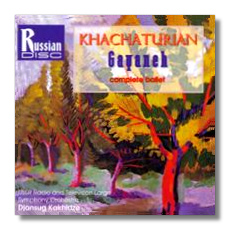
The Internet's Premier Classical Music Source
Related Links
- Khachaturian Reviews
- Latest Reviews
- More Reviews
-
By Composer
-
Collections
DVD & Blu-ray
Books
Concert Reviews
Articles/Interviews
Software
Audio
Search Amazon
Recommended Links
Site News
 CD Review
CD Review
Aram Khachaturian

Gayaneh - Complete Ballet
USSR Symphony Orchestra/Djansug Kakhidze
Russian Disc 11029 (Koch) 2CD 143min
Kakhidze's 1976 recording employs the revised version of Gayne prepared by Khachaturian for a 1957 Bolshoi production. It is both more "symphonic" and less satisfying than the 1942 original. The new libretto purged most of the Stalinist excesses of the first version, but, alas, the composer jettisoned much of the score's best and most colorful music at the same time. There are, for example, tantalizing hints of the beautiful and justly famous Adagio (which Stanley Kubrick used to memorable effect in his classic film, 2001), but it is never heard in its entirety. Fortunately, some of the new material that Khachaturian inserted in place of the ethnic dances that permeated the original is often appealing and quite distinctive. 'Aisha's Recovery' (Act 1) is a delightful stew consisting of elements of Prokofieff (a tender waltz that would not have been out of place in Cinderella) combined with the sound of a circus band and a dash of Armenian flavoring. There is also a delightful 'Men's Dance' in Act 3 boasting an exotic, Klezmer-style duet for clarinet and trumpet. Perhaps most fascinating of all is the wacky 'Dance of the Young Girls', also from Act 3, which I can only describe as an American cowboy song inflected with a distinctly Armenian twang. Unfortunately, far too much time is devoted to Khachaturian's lame attempts to "develop" (i.e. repeat with only minor modifications) familiar material which is already quite repetitious to begin with. The scoring is, if anything, even less subtle than the original, and the incredibly lush string writing makes one wonder if the ballet's setting was changed from an Armenian village to a Hollywood soundstage.
Kakhidze is an efficient but not always effective interpreter. He all too often rushes the fast numbers in a stiff and mechanical manner, as if he can't wait to be done with them. 'The Hunters Test Armen' and 'Nuneh and Armen's Dance', both from Act 2, demonstrate this flaw. Yet when he does relax and bask in the score's vivid colors, Kakhidze can be very compelling – as in Aisha's Act 3 monologue, with its evocative saxophone and irresistibly coy conclusion. Kakhidze nonetheless has a disturbing tendency to allow counter-melodies and subsidiary material to become overly prominent, such as the annoying trumpet which mars an otherwise pleasant reading of the Act 2 'Girls' Dance'. Russian Disc's recording is harsh, unpleasant, occasionally distorted, and poorly balanced (the percussion instruments sound very thin and distant). Severe tape dropouts plague the left channel of Nuneh's Act 3 dance, suggesting that the master tape has been badly damaged.
Anichanov reverts to the more earthy and entertaining first version of Gayne. While this disc certainly does not replace Tjeknavorian's classic RCA recording (LP, long overdue for CD reissue), it does present much of the ballet's finest music – including the Adagio! – in generally satisfying performances and acceptable sound at a bargain price. A word of warning: these are not the same "Suites 1-3" that Tjeknavorian recorded, though there is some overlap between the two collections. Further, RCA's two LPs boasted nearly twice as much music as this single Naxos disc.
The score's quieter moments – the Lullaby and Adagio in particular – are magical and thoroughly satisfying in Anichanov's hands. (Oddly, this version of the Adagio begins with a solo cello, rather than the full cello section as indicated in my score and as performed by Tjeknavorian.) Anichanov even manages to make the overplayed 'Sabre Dance' seem refreshing. While neither as charming nor authoritative as Tjeknavorian, Anichanov is vastly more satisfying than the superficial and madly driven Kakhidze.
The St. Petersburg State Symphony plays every bit as well – if not slightly better than – their comrades in the USSR Symphony. Naxos' recording was made from a rather distant perspective. As a result, the percussion lacks presence, and the strings are occasionally smothered by the winds and brass. However, in contrast to the Russian Disc issue, Naxos' bass is both solid and realistic. For two seconds at 1:24 in track 13 the right channel level drops drastically, as if someone accidentally brushed the volume control knob while the master tape was prepared – but that is only a minor irritation. Indeed, my only serious reservation is that the short playing time left plenty of room for even more highlights, such as the infectious Lezghinka.
Copyright © 1996, Thomas Godell


















